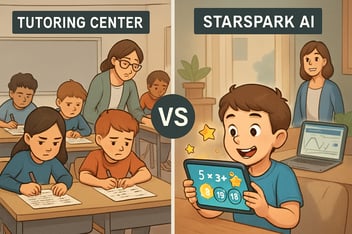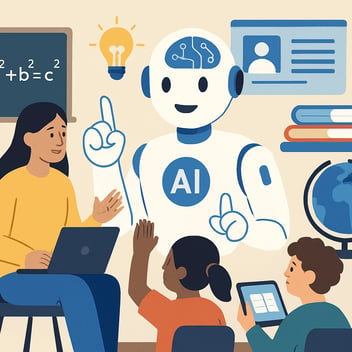
Choosing the right math program for your child can feel overwhelming. Between Kumon, RSM, Singapore Math, and newer approaches like AI tutoring, parents are flooded with options that all promise better results.
But which math system fosters true mathematical understanding?
Here’s what you need to know about today’s leading math methods, the pros and cons of rote learning, and how StarSpark.AI helps bring it all together for deeper, lasting success.
Understanding the Most Popular Math Systems
Math education looks different across the world. Each country and program follows its own philosophy, shaped by culture and learning priorities. For parents, understanding these systems is the first step toward finding what truly fits your child’s needs.
In Japan, lessons center around problem-solving and conceptual understanding. Students explore multiple ways to reach an answer, which strengthens reasoning and collaboration.
The Russian system is known for its rigor and depth, building logical and theoretical thinking through structured proofs and step-by-step problem-solving.
Singapore Math, now adopted in classrooms worldwide, emphasizes visualization and comprehension. Students use bar models and real-world examples to break down complex questions and see the why behind each step.
In North America, approaches are more diverse, often blending traditional arithmetic with modern, inquiry-based learning.
The Vedic (Indian) system, rooted in ancient methods, uses mental math patterns and shortcuts to make calculations faster and more intuitive.
For parents comparing these methods, the variety can be overwhelming. Each offers unique benefits — the key is choosing one that builds understanding rather than memorization, and encourages confidence as much as accuracy.
To see how these strengths come together through modern technology, explore The StarSpark Method — a research-based approach that combines global best practices with adaptive AI to make math learning both personal and powerful.
Kumon
Kumon is one of the most widely recognized after-school math programs. It emphasizes daily practice and repetition to build fluency and confidence. The structure promotes consistency and discipline, but it often focuses more on memorization and speed than on understanding why a solution works.
RSM (Russian School of Mathematics)
RSM follows a theory-based model that emphasizes logic and reasoning. It challenges students with abstract problems, helping them develop strong analytical skills. While it builds depth, some students may find its structure intense or less flexible.
Singapore Math
Singapore Math is praised worldwide for its focus on conceptual mastery. It uses visual models and real-world examples to help students understand how and why mathematical relationships work. This method builds lasting problem-solving ability rather than short-term memorization.
Other Global Methods
The Japanese approach blends collaboration with multi-step reasoning, while the Vedic (Indian) system develops quick, intuitive calculation skills. Many educators now mix techniques from several systems to create a balanced and adaptive learning experience, an idea that aligns closely with how StarSpark approaches modern math education.
The Downside of Rote Learning
This method can lead to frustration and a lack of interest in mathematics, as students may struggle to apply their knowledge to new problems or real-life situations. In contrast, a focus on critical thinking and problem-solving skills is essential for developing a true appreciation and understanding of math.
Rote memorization has long been a staple in traditional math education. It involves memorizing facts and formulas without understanding their underlying principles, and is often criticized for its limitations. Memorization may help on short-term tests, but it rarely leads to lasting understanding.
Students who learn by memorization alone often struggle to apply their knowledge to new types of problems. Over time, that can create anxiety, low confidence, and even a dislike of math.
True mathematical fluency comes from understanding concepts, not just recalling steps. That’s why systems like Singapore Math and modern AI platforms are moving toward inquiry-based, conceptual learning.
The StarSpark Approach: Building Conceptual Understanding Over Memorization
At StarSpark.AI, we believe the best math learning combines structure with flexibility and technology with teaching.
Our AI math teachers don’t rely on repetition or rote drills. Instead, they teach students to think critically, reason through problems, and understand the “why” behind every answer.
For example, instead of simply showing that 4³ = 64, StarSpark might guide a student to explore: What other base and exponent pairs could make 64? That two-way reasoning deepens understanding and strengthens number sense.
Because every child learns differently, StarSpark adapts in real time, adjusting the level of difficulty, offering hints when needed, and celebrating progress to keep motivation high.
Real-World Application: Making Math Relevant
Math feels easier when it makes sense. That’s why StarSpark connects math problems to real-life scenarios. From budgeting for a class trip to measuring ingredients in a recipe, students learn how math applies to their world.
This real-world approach keeps learning meaningful and helps students retain what they’ve learned far beyond the classroom. It also builds confidence, showing kids that math isn’t something to fear, but it’s a skill they already use every day.
Choosing the Right System for Your Child
Finding the right program depends on your child’s learning style, pace, and goals. Here are a few key questions to ask:
-
Does this system focus on understanding or memorization?
-
Will it adapt to my child’s strengths and weaknesses?
-
Does it connect math to real-world examples?
-
Will it keep my child motivated and confident?
If your child thrives on independence, curiosity, and hands-on problem-solving, look for a system that supports conceptual learning, not rote repetition.
That’s exactly what StarSpark.AI delivers: the structure of proven global math methods combined with the personalization and instant feedback only AI can provide.
Why More Parents Are Turning to StarSpark.AI
StarSpark brings together the best of every system — the consistency of Kumon, the logic of RSM, and the visualization of Singapore Math — all enhanced by adaptive AI technology.
Students get guided, one-on-one math support anytime they need it. Parents gain visibility into progress without having to reteach lessons at home. And teachers benefit from a partner tool that reinforces classroom learning with accuracy and engagement.
Whether your child is catching up or ready to move ahead, StarSpark offers the flexibility and depth traditional programs can’t match.
If you want your child to not just do math but truly understand it, there’s no better place to start than StarSpark AI.
Frequently Asked Questions
Which math program is best for my child?
The best math program depends on how your child learns. Kumon focuses on repetition and accuracy, RSM builds logical and analytical thinking, and Singapore Math encourages deep understanding through visualization. StarSpark.AI combines the strengths of each system with adaptive technology that personalizes math learning for every student.
Is Singapore Math better than Kumon?
Singapore Math helps students understand the reasoning behind problems, while Kumon develops speed and discipline through consistent practice. Each approach has benefits, but StarSpark.AI unites the best of both by building conceptual understanding and fluency together through guided, personalized learning.
What makes StarSpark.AI different from other math programs?
StarSpark.AI is designed to teach real understanding, not memorization. It combines proven global teaching methods with adaptive AI that responds to each child’s learning style, ensuring lessons are accurate, engaging, and curriculum-aligned.
Can AI really help kids learn math?
Yes. When developed for education, AI can make math learning more effective and accessible. StarSpark.AI uses precise math solvers and mistake-aware feedback to explain each step clearly and help students build lasting confidence in their skills.
How do I choose the right math system as a parent?
Look for a system that fits your child’s strengths and learning preferences. Prioritize conceptual understanding, adaptability, and engagement. Programs like StarSpark.AI make it easy to start at the right level and grow at the right pace, giving your child both confidence and mastery.





